

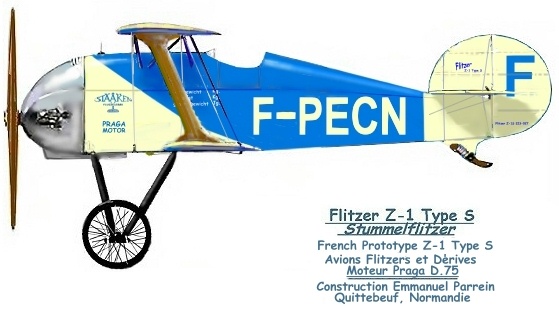
 |
 |
|||
| 1 | 2 | 3 | ||
Sent: Saturday, August 25, 2001 11:37 AM
Subject: Fw: Stummelflitzer Normandie
Dear Richard,
Welcome to the 'Flitzer Builders' site and thank you for your enquiry regarding Z-21&21A and Z-1 Type S drawings.
The basic Flitzer, stemming from the Z-1 prototype, was designed as a 'proof-of-concept' vehicle for small VW biplanes having similar geometry, dynamics, and mass, for a variety of sportplane developments, and scaled 'fighter replicas'.
The position with the Type S Stummelflitzer is that some 60% of the drawings are completed to 'production standard', and are lodged with the PFA's Engineering Archive. I had previously been assured that because the new design represented a considerable improvement in strength and stiffness, utilising as it does, increased spar cross-sectional areas (Z-moduli), substitution of Douglas fir in some areas, and other improvements, that it would not be necessary to run a complete stress analysis on the airframe, based as it is on the successful Z-21, which is itself 'aerobatic' by any normal system of measurement, ie. when compared to the Isaacs Fury, Currie Wot, etc.
Fitting commonality with the Z-21 is of a high order, and some simplifications are introduced into the basic structure, although this is mitigated somewhat by the extra work involved in building a second set of shorter ailerons, link struts, etc.
Recently, however, I have been asked about providing further stressing for this model, which as you can imagine, would be a considerable financial burden if this were to be required for every development type, and was not budgeted for when creating a family tree, featuring quite conservative evolutionary development.
Five Stummelflitzers are currently being built, four in France and one in Canada, with my own 'S' prototype 'stalled' at present, due to other pressing work, not least keeping up with design demand. These aeroplanes are being constructed in the full knowledge that the first to be completed will be the initial flight-test prototype of the 'S', and will be thoroughly test flown in accordance with the requirements and protocols in force in the appropriate country (France). The RSA is prepared to accept the design as a bona fide development of an exisiting, approved design, and does not require a major stress programme in view of the acknowledged improvements in key areas.
This is not to say that the currently PFA approved Z-1 (or the series Z-21) is in any way a 'weak' aeroplane, having a factor of safety of at least 1.5 above Normal Cat. requirement of 3.8g in all areas, and of 2.0+ in several areas, on the original prototype, which uses mild steel fittings, has a slender tailplane section, etc. The plans-built Z-21 utilises 4130N steel fittings and has had all factors of around 1.5 increased by analysis, and also features a deeper section tailplane of increased area (106% of the Z-1 TP).
Incidentally, on the approach to land, one pilot levelling out at about 10', subjected the Z-1 prototype to an indicated -7g on the accelerometer, which bent the axle 10 degrees (this was subsequently sleeved to increase its wall thickness to that now shown on the plans). After carrying out a heavy landing check, no other damage had occurred to the machine. This is a tough aeroplane.
The position is that I have not yet offered the Type S drgs. for sale in the UK. That the Type S will achieve full Permit approval in the UK and elsewhere I have no doubt, and no criticism has been made of the design. Where part sets of the Type S have been sold, it is on the understanding that purchase of a full set of 32 Z-21 drawings (which includes the 'wide bodied' Z-21A model) is de rigeuer, since they effectively provide a build manual for the entire Z-series, with many elements in common. These retail for £130 in the UK. The complete set of Stummelflitzer drgs. will amount to some 13 sheets (minimum), mostly A1 sized, with all metal parts and several major components drawn full size, and cost a further £50 per set. [Editor's Note: These are NOT current prices] Provision for a slimline back parachute is a feature of the S.
Since the demise of Bell Aeromarine, no off-the-shelf Flitzer components are available, but all metal fittings are designed for simplicity, and have been kept to a minimum for a wooden biplane. [Editor's note: Gary Steadman at Flitzer-Aero.com now offers metal fitting kits, as well as plans and materials kits.] I can undertake the fabrication of wheels, based on builder's supplied hubs (made from the drawings) and built to the best standard and featuring offset-angled spokes for coping with side loadings, for no handling charge. My dream is to see a sky full of Flitzers. It's so much fun, it would be a shame to keep it all a secret!
Sincerely,
Lynn Williams
PS. I append some pictures of the most advanced French Stummel, taken some months ago.
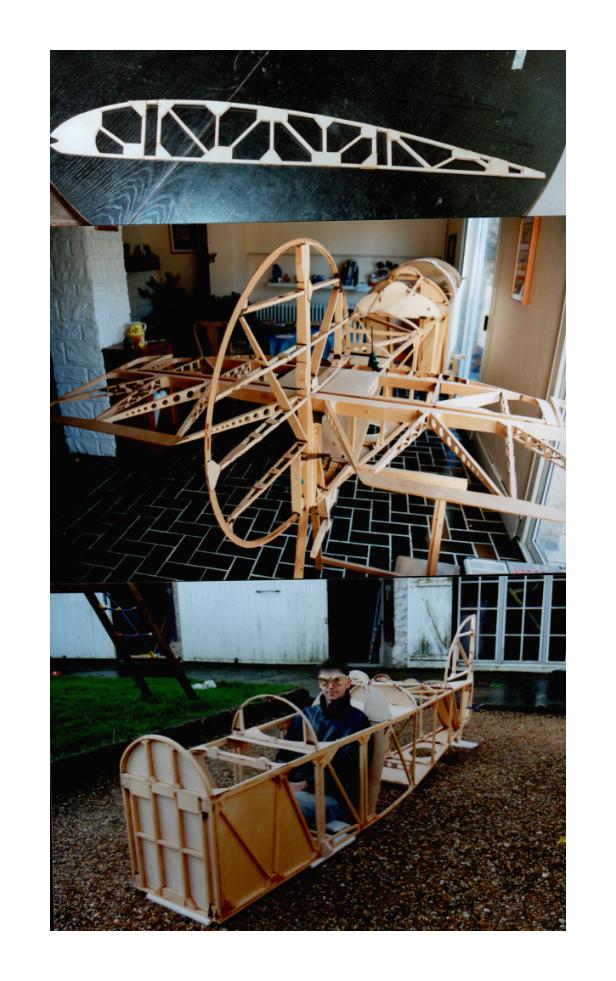
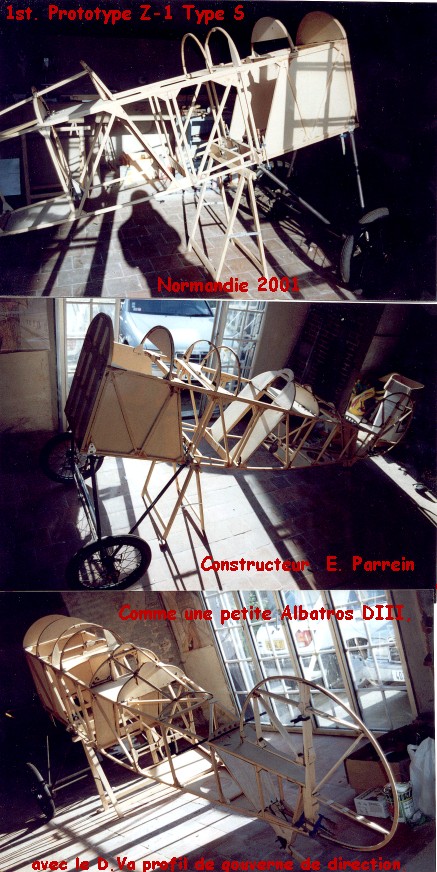
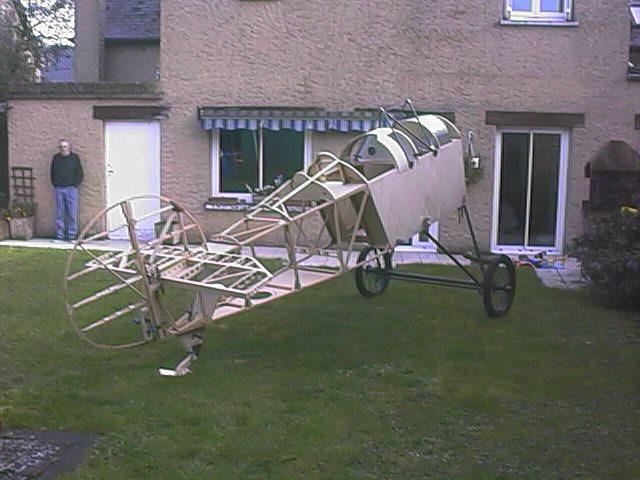
Hi Flitzerbuilders,
The attached shows the great progress on the first French-built Flitzer Z-1 Type S Stummelflitzer, No. 37, built by Emmanuel Parrein in Normandy, one of six such aeroplanes currently under construction or proposed, in Europe, the UK and Canada.
This machine is being built from original Z-1S drawings, in combination with the standard Z-21 drawing set as 'build manual', and via frequent direct contact with the designer.
The Z-1S differs from the prototype Z-1 and Z-21 types, in having deeper wing spars and longer chords, rounder wing tips, slightly shorter, unequal, upper and lower wing spans and four mass-balanced ailerons. The fuselage is more compact, and the engine bay provides for alternative motors with a wider range of power output and installed weight.
The tailgroup is redesigned, the vertical surfaces having an elliptical profile, while the horizontal tail has a partly-swept leading edge and mass and aerodynamically balanced elevators. Decking has a built-in streamline headfairing, to reduce form drag and turbulence around the rear of the cockpit rim.
Like the Z-21, the design is intended for aerobatics, but is more robust, capable of higher rates of roll, and more advanced positive manoeuvres.
If anyone else has some progress pictures, let's see 'em!
Best wishes everyone,
Lynn
November 20, 2004
I forgot to mention that the Praga D that Emmanuel is installing in his Stummelflitzer Type S is merely a four-cylinder version of the B, developing 75 hp.
Best wishes,
Lynn
September 15, 2005
Group,
Here's another scheme - this time for Emmanuel Parrein, whose Z-1S is currently the most advanced of that type, although Vic Long is catching him up! I have added cream to the Bugatti blue fuselage to complement the blue and cream chevrons he is thinking if adding to the wings. A plan view will follow soon.

Here is the blue-cream scheme in plan form. The cream nose element links with a more pronounced curve on the lower wing chevrons, while those on the upper wing meet in two smaller radii each side of the LE centreline.
For one of the 'dedicated aerobatic' types I don't think the scheme is too overt, and actually compares to a post-WW1 scheme worn by Alfred Fronval's Morane A-1.
Cheers,
Lynn
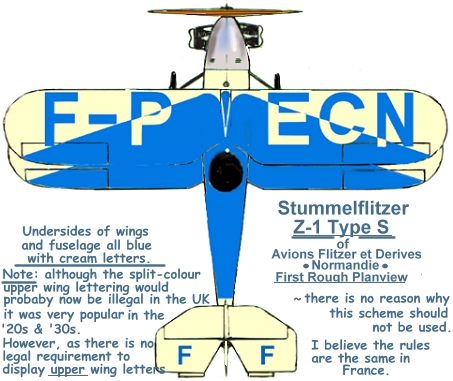
September 18, 2005
Group,
Herewith Emmanuel's overall colour scheme.
Lynn
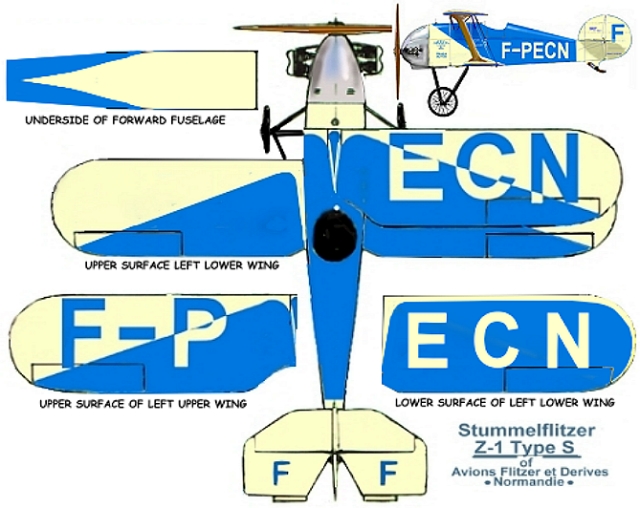
 |
 |
|||
| 1 | 2 | 3 | ||